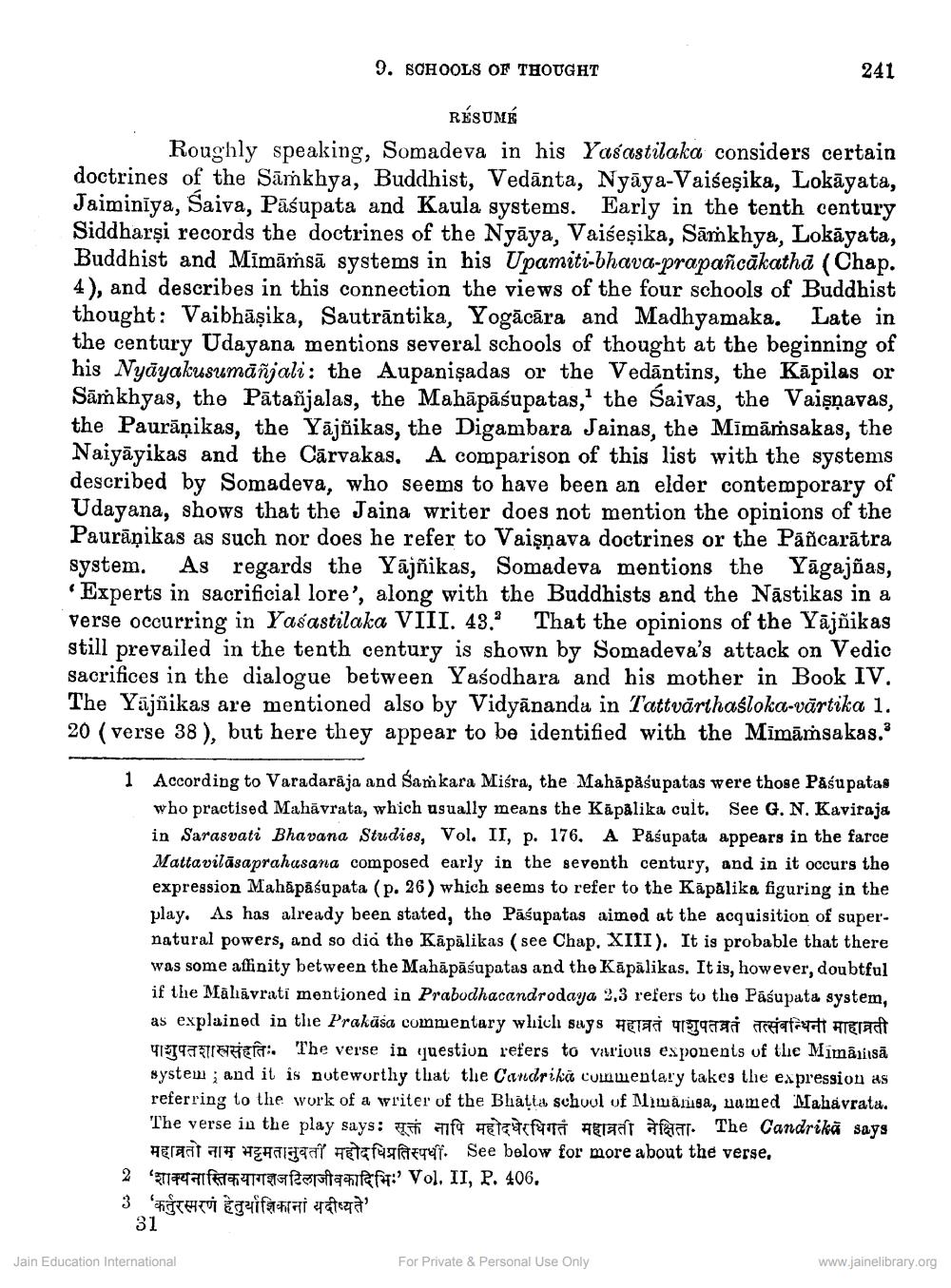________________
9. SCHOOLS OF THOUGHT
241
RÉSUMÉ Roughly speaking, Somadeva in his Yasastilaka considers certain doctrines of the Sāṁkhya, Buddhist, Vedānta, Nyāya-Vaišeşika, Lokāyata, Jaiminiya, Saiva, Pāśupata and Kaula systems. Early in the tenth century Siddharşi records the doctrines of the Nyāya, Vaiseșika, Sāmkhya, Lokāyata, Buddhist and Mimāṁsā systems in his Upamiti-bhava-prapancākatha (Chap. 4), and describes in this connection the views of the four schools of Buddhist thought: Vaibhāşika, Sautrāntika, Yogācāra and Madhyamaka. Late in the century Udayana mentions several schools of thought at the beginning of his Nyāyakusumāñjali: the Aupanişadas or the Vedāntins, th Sāṁkhyas, the Pātañjalas, the Mahāpāśupatas,' the Saivas, the Vaişņavas, the Paurāņikas, the Yājñikas, the Digambara Jainas, the Mimāṁsakas, the Naiyāyikas and the Carvakas. A comparison of this list with the systems described by Somadeva, who seems to have been an elder contemporary of Udayana, shows that the Jaina writer does not mention the opinions of the Paurānikas as such nor does he refer to Vaisnava doctrines or system. As regards the Yājñikas, Somadeva mentions the Yāgajñas, • Experts in sacrificial lore', along with the Buddhists and the Nāstikas in a verse occurring in Yasastilaka VIII. 43. That the opinions of the Yājñikas still prevailed in the tenth century is shown by Somadeva's attack on Vedic sacrifices in the dialogue between Yasodhara and his mother in Book IV. The Yājñikas are mentioned also by Vidyānanda in Tattvārthaśloka-vārtika 1. 20 (verse 38), but here they appear to be identified with the Mimāṁsakas.
1 According to Varadarāja and Saṁkara Miśra, the Mahāpåśupatas were those Pasupatas
who practised Mahāvrata, which usually means the Kāpålika cult. See G. N. Kaviraja in Sarasvati Bhavana Studies, Vol. II, p. 176. A Pasupata appears in the farce Mattavilāsaprahasana composed early in the seventh century, and in it occurs the expression Mahāpāśupata (p. 26) which seems to refer to the Kāpalika figuring in the play. As has already been stated, the Pāśupatas aimed at the acquisition of supernatural powers, and so dia the Kāpālikas (see Chap. XIII). It is probable that there was some affinity between the Mahāpāśupatas and the Käpälikas. It is, however, doubtful if the Malavrati mentioned in Prabodhacandrodaya 2,3 refers to the Pasupata system, as explained in the Prakāsa commentary which says महाव्रतं पाशुपतव्रतं तत्संबन्धिनी माहाव्रती 4131975THREAT: The verse in questiun refers to various exponents of the Mimārsā system; and it is noteworthy that the Candrikä сumnwentary takes the expression as referring to the work of a writer of the Bhatta school of Miwaruga, named Mahavrata. The verse in the play says: सूक्तं नापि महोदधेरधिगत महाव्रती नेक्षिता. The Candrika says
महाव्रतो नाम भट्टमतानुवती महोदधिप्रतिस्पर्धी. See below for more about the verse. 2 T14 FEAT Teftariqaft:' Vol. II, p. 406. 3 HOTEuifki atza' 31
Jain Education International
For Private & Personal Use Only
www.jainelibrary.org




